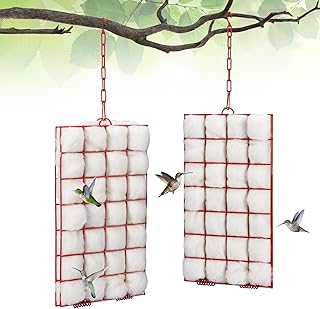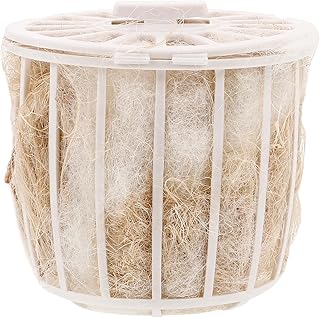Every spring, the United States and Canada are graced by the arrival of hummingbirds migrating northward to establish nests for their soon-to-be-born offspring. These incredible little travelers make their long journey from Mexico and South America, seeking a cooler and more suitable climate where they can raise their families.
The decision of where to build their nests is crucial, as the survival of their young depends on it. They need a safe, sheltered spot that provides access to nectar and protection from predators. But finding the perfect location is only part of the challenge. Once they’ve chosen their ideal spot, the real task begins: constructing a nest. For a pregnant hummingbird, this delicate and demanding task becomes even more difficult, requiring extraordinary skill, precision, and energy to create a secure and comfortable home for her future family.
This time lapse video shows a hummingbird building her nest
Protection from weather and heat in nest location.
When a female hummingbird is selecting the ideal site for her nest, two priorities take precedence: maintaining a suitable temperature and ensuring protection from the elements. Above all, the mother must ensure that the temperature remains below 96 degrees Fahrenheit, as any higher could result in the embryos being overheated and ultimately destroyed. This need for temperature control is why higher altitudes are particularly attractive to nesting hummingbirds, as the cooler environment helps keep the conditions within the safe range. Additionally, areas near bodies of water are often favored, as the natural surroundings can provide a cooling effect.
How they beat the heat
However, some hummingbird species, like the Ruby-throats, have adapted to “beat the heat” even at lower elevations. These birds seek refuge in the canopies of broad-leafed trees, where temperatures are typically about 6 degrees Fahrenheit cooler than in the open air. This cooler shelter not only prevents overheating but also allows the hummingbirds to thrive in warmer areas that would otherwise be inhospitable. These trees also serve as a shield from harsh weather elements, particularly wind, which can be particularly dangerous for young birds and delicate nests.
Shelter from the wind
Protection from high winds is a critical factor in a hummingbird’s choice of nesting site. Strong gusts can easily damage the nest or cause the eggs to roll out, which may lead to the loss of the eggs or make them vulnerable to predators. The mother must therefore be diligent in choosing a location where her nest will remain sheltered from such hazards. All of these considerations—temperature, protection from wind, and shelter from other adverse weather—play a vital role in the selection process. Once the mother hummingbird has found the ideal spot, the next step is to begin building her nest, where she will carefully create a safe haven for her future offspring.
Here’s an informative video on hummingbird nesting
Don’t believe the scam. Here is the real truth
Why hummingbird don’t nest in hummingbird houses
No male hummingbirds allowed
The Male’s Brief Role in Nesting
During the nesting process of hummingbirds, the male plays a vital but short-lived role. His primary function is to fertilize the female, and once this task is complete, he is promptly sent away. While his brilliant, colorful feathers are a symbol of vitality and attractiveness, they also pose a significant risk. The vivid plumage that helps him attract a mate makes him highly visible to predators. Once the female is fertilized, she instinctively knows it’s time for him to leave, as his presence could jeopardize the safety of the nest.
The Female Takes Charge
With the departure of the male, the female assumes full responsibility for the nest. This marks the beginning of her most critical duties, and she tackles them with exceptional intelligence and dedication. She now must protect and care for the eggs or young chicks, using all of her resourcefulness to keep them safe from any threats. Unlike many other species, hummingbirds do not rely on the male for assistance after fertilization. The female is entirely on her own during this final stage of nesting.
Protection and Resourcefulness
The female hummingbird demonstrates remarkable resourcefulness and intelligence in safeguarding her nest. Hummingbirds are known for their quick reflexes and sharp minds, and the female uses these traits to defend her territory. She may create distractions to lead predators away or use her speed and agility to fend off any threats. Her small size allows her to maneuver quickly, making it difficult for predators to catch her or get close to the nest.
Balancing Nurturing and Defense
One of the most impressive aspects of the female hummingbird’s nesting behavior is her ability to balance the nurturing of her young with the defense of the nest. She must remain vigilant to ensure her eggs or chicks are safe, while also maintaining her energy and focus to protect them from larger animals. Whether by intimidating intruders or using her aerial agility to escape danger, the female hummingbird’s defense tactics are as strategic as they are effective.
Masters of Survival
Though they are small and delicate in appearance, hummingbirds are incredibly resilient and resourceful when it comes to survival. The female’s role in protecting the nest showcases not only her fierce determination but also her intelligence. She demonstrates the hummingbird’s ability to thrive in the face of adversity, ensuring that the next generation of these stunning creatures has the best chance of survival. In this way, hummingbirds are not just marvels of nature’s beauty but also masters of their environment.
Here’s some more information on hummingbird nesting and baby hummingbirds.
A great video on hummingbird nesting!
Helping Hummingbirds During the Nesting Season: Supplying Nesting Materials
Hummingbirds are fascinating creatures that play an important role in ecosystems by pollinating plants as they feed on nectar. During the nesting season, they require a safe and supportive environment to build their nests and raise their young. As a homeowner or gardener, you can help these tiny birds by providing nesting materials that will support their efforts. Here’s how you can assist hummingbirds during the nesting season.
Why Hummingbirds Need Help
Hummingbirds typically build their nests using natural materials like spider silk, plant down, cotton, and feathers. However, these materials can sometimes be hard to find, especially if the area around their habitat lacks the appropriate resources. Providing additional nesting materials can make a significant difference, ensuring the birds have what they need to successfully raise their young.
The Importance of a Secure Nest
The nesting period for hummingbirds can be delicate, as they rely on the stability and comfort of their nests to protect their eggs and keep their chicks safe. A well-constructed nest will be secure enough to withstand weather changes, predators, and the inevitable wear and tear that comes with raising young. By helping provide the right materials, you give these birds a better chance of survival and reproduction.
Types of Nesting Materials to Provide
To assist hummingbirds, you can provide a variety of materials that closely resemble what they naturally use. Some excellent options include:
1. Spider Silk
Spider silk is a vital component of hummingbird nests due to its lightweight and stretchy qualities. It allows the nest to expand as the chicks grow. You can leave out strands of spider silk or even small cobwebs in your yard to help hummingbirds.
2. Feathers
Soft feathers provide insulation for the nest, helping to keep the eggs warm. You can find feathers from various birds in your yard or even buy feathers from a pet supply store. Ensure the feathers are clean and free from chemicals that might harm the birds.
3. Cotton and Plant Down
Natural cotton (such as from cottonwood trees) or plant down (such as dandelion fluff) is soft and airy. These materials help hummingbird nests stay insulated and comfortable. You can offer cotton balls, but make sure they are made from natural fibers and not synthetic materials.
4. Animal Hair
Hair from your pets (such as from a dog or cat) can be a great nesting material. Hummingbirds often use hair for its insulating properties. Make sure the hair is clean and free from any chemicals that could be harmful.
5. Natural Twigs and Plant Fibers
While hummingbirds don’t typically build their nests with large twigs, they may incorporate small twigs and plant fibers. You can offer small lengths of natural twigs or fiber from plants like pampas grass.
How to Provide Nesting Materials
Offering materials in a way that makes them easy for the hummingbirds to find is important. Here are a few simple methods to help:
1. Create a Nesting Station
You can place the nesting materials in a mesh bag or hanging basket. Ensure that the materials are secure but easily accessible. If you hang it from a tree or shrub, the birds will be able to pull the materials they need.
2. Scatter Materials Around the Yard
Place small piles of feathers, cotton, and other materials around your garden, especially near flowering plants that hummingbirds frequent. The more accessible the materials are, the more likely the birds will use them.
3. Leave Some Spider Webs Intact
If you have any spider webs on your property, try leaving them undisturbed. These are excellent sources of spider silk, which hummingbirds can easily gather to weave their nests.
Conclusion
Providing nesting materials for hummingbirds is a thoughtful and easy way to contribute to their survival during the nesting season. By offering the right materials—like spider silk, feathers, cotton, and animal hair—you can help ensure that these delicate birds have everything they need to build secure and comfortable nests. With your assistance, hummingbirds will have a better chance of successfully raising their young, all while continuing their important role in pollination and maintaining the beauty of your garden.
Click on the link to view all the different hummingbird nesting materials available at Amazon.com.
Hummingbirds are not known to nest in houses
Hummingbirds prefer to build their nests in natural environments such as trees, shrubs, or vines, where they can find the appropriate shelter and food sources. However, if you’re looking to attract these tiny, fascinating creatures to your garden, you can provide them with nesting platforms. These platforms mimic the support of branches and can be positioned in your yard to offer a safe, stable spot for hummingbirds to build their nests. By adding such a platform, along with providing food sources like nectar-rich flowers or hummingbird feeders, you can create a more inviting environment for them to thrive. Go to Amazon.com to see their selection.
More hummingbird resources
U.S. Fish and Wildlife Service – Hummingbird Conservation
This site offers detailed information about various hummingbird species, their habitats, and conservation efforts. It also provides resources on how to protect these fascinating birds.
National Park Service – Hummingbird Resources
The National Park Service offers insights into hummingbird species found in national parks, their behaviors, and their role in ecosystems, along with tips for observing them.
Smithsonian National Museum of Natural History – Birds: Hummingbirds
This resource provides educational materials on the role of hummingbirds in pollination and biodiversity, backed by scientific research and exhibits from the Smithsonian.
U.S. Geological Survey – Hummingbird Studies
The USGS offers research on hummingbird migration patterns, population dynamics, and environmental threats, including studies on climate change impacts.
The Cornell Lab of Ornithology – Hummingbirds
While not strictly a government site, Cornell partners with federal agencies to provide valuable scientific insights into hummingbird behavior, conservation, and field guides.






